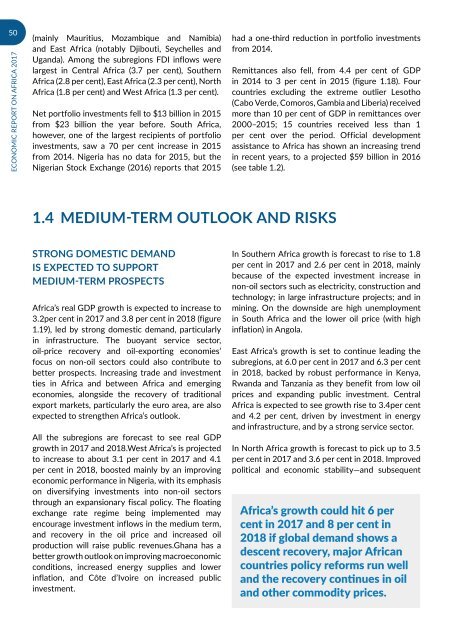URBANIZATION AND INDUSTRIALIZATION
Economic%20Report%20on%20Africa%202017%20UNECA
Economic%20Report%20on%20Africa%202017%20UNECA
You also want an ePaper? Increase the reach of your titles
YUMPU automatically turns print PDFs into web optimized ePapers that Google loves.
50<br />
ECONOMIC REPORT ON AFRICA 2017<br />
(mainly Mauritius, Mozambique and Namibia)<br />
and East Africa (notably Djibouti, Seychelles and<br />
Uganda). Among the subregions FDI inflows were<br />
largest in Central Africa (3.7 per cent), Southern<br />
Africa (2.8 per cent), East Africa (2.3 per cent), North<br />
Africa (1.8 per cent) and West Africa (1.3 per cent).<br />
Net portfolio investments fell to $13 billion in 2015<br />
from $23 billion the year before. South Africa,<br />
however, one of the largest recipients of portfolio<br />
investments, saw a 70 per cent increase in 2015<br />
from 2014. Nigeria has no data for 2015, but the<br />
Nigerian Stock Exchange (2016) reports that 2015<br />
had a one-third reduction in portfolio investments<br />
from 2014.<br />
Remittances also fell, from 4.4 per cent of GDP<br />
in 2014 to 3 per cent in 2015 (figure 1.18). Four<br />
countries excluding the extreme outlier Lesotho<br />
(Cabo Verde, Comoros, Gambia and Liberia) received<br />
more than 10 per cent of GDP in remittances over<br />
2000–2015; 15 countries received less than 1<br />
per cent over the period. Official development<br />
assistance to Africa has shown an increasing trend<br />
in recent years, to a projected $59 billion in 2016<br />
(see table 1.2).<br />
1.4 MEDIUM-TERM OUTLOOK <strong>AND</strong> RISKS<br />
STRONG DOMESTIC DEM<strong>AND</strong><br />
IS EXPECTED TO SUPPORT<br />
MEDIUM-TERM PROSPECTS<br />
Africa’s real GDP growth is expected to increase to<br />
3.2per cent in 2017 and 3.8 per cent in 2018 (figure<br />
1.19), led by strong domestic demand, particularly<br />
in infrastructure. The buoyant service sector,<br />
oil-price recovery and oil-exporting economies’<br />
focus on non-oil sectors could also contribute to<br />
better prospects. Increasing trade and investment<br />
ties in Africa and between Africa and emerging<br />
economies, alongside the recovery of traditional<br />
export markets, particularly the euro area, are also<br />
expected to strengthen Africa’s outlook.<br />
All the subregions are forecast to see real GDP<br />
growth in 2017 and 2018.West Africa’s is projected<br />
to increase to about 3.1 per cent in 2017 and 4.1<br />
per cent in 2018, boosted mainly by an improving<br />
economic performance in Nigeria, with its emphasis<br />
on diversifying investments into non-oil sectors<br />
through an expansionary fiscal policy. The floating<br />
exchange rate regime being implemented may<br />
encourage investment inflows in the medium term,<br />
and recovery in the oil price and increased oil<br />
production will raise public revenues.Ghana has a<br />
better growth outlook on improving macroeconomic<br />
conditions, increased energy supplies and lower<br />
inflation, and Côte d’Ivoire on increased public<br />
investment.<br />
In Southern Africa growth is forecast to rise to 1.8<br />
per cent in 2017 and 2.6 per cent in 2018, mainly<br />
because of the expected investment increase in<br />
non-oil sectors such as electricity, construction and<br />
technology; in large infrastructure projects; and in<br />
mining. On the downside are high unemployment<br />
in South Africa and the lower oil price (with high<br />
inflation) in Angola.<br />
East Africa’s growth is set to continue leading the<br />
subregions, at 6.0 per cent in 2017 and 6.3 per cent<br />
in 2018, backed by robust performance in Kenya,<br />
Rwanda and Tanzania as they benefit from low oil<br />
prices and expanding public investment. Central<br />
Africa is expected to see growth rise to 3.4per cent<br />
and 4.2 per cent, driven by investment in energy<br />
and infrastructure, and by a strong service sector.<br />
In North Africa growth is forecast to pick up to 3.5<br />
per cent in 2017 and 3.6 per cent in 2018. Improved<br />
political and economic stability—and subsequent<br />
Africa’s growth could hit 6 per<br />
cent in 2017 and 8 per cent in<br />
2018 if global demand shows a<br />
descent recovery, major African<br />
countries policy reforms run well<br />
and the recovery continues in oil<br />
and other commodity prices.


